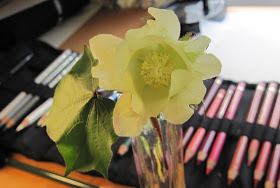Goin' Legal
We all know that it is illegal to grow...er...certain plants, right? But some plants growing in your back yard can get you so...busted.... Not that I am admitting to anything here, but supposed a woman legally purchased a seed to grow a pretty plant to, say, draw because she was a botanical illustrator and curious gardener. And she grew it (hypothetically) and then found out it was illegal! What is a person to do?
Nope, I am not thinking of the plant you might be thinking of... (of which you might be thinking, to be grammatical?). I am thinking of growing...cotton. Yes, cotton. Cotton is a pretty plant in the hibiscus family that just happens to produce a usable fiber in a seed pod structure called a boll. And there's the rub. Ever hear of the boll weevil? This nefarious little insect lays eggs on developing cotton bolls and the larva develops inside, ruining the cotton (this historically caused great economic damage to the South). Virginia is a state that is under the Federal Boll Weevil Eradication Program. To grow cotton in the state, you need to register, pay a per acre fee and set up boll weevil monitoring traps. Unless you are like me, and are going to be growing cotton in a pot on your back porch for non-commercial use of that cotton. In that case, you can easily get a waiver (and boy was that fast) from the state to grow the cotton!
Isn't it a pretty flower? It matures from cream to pink before it fades.
I love being legal!
Happy Gardening!
.JPG)


.JPG)


